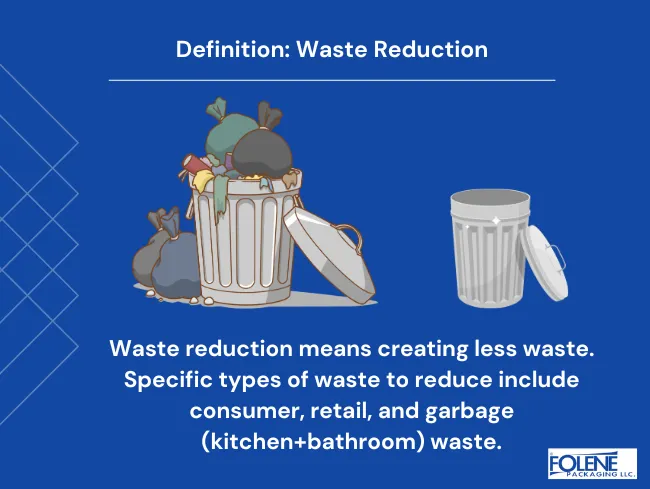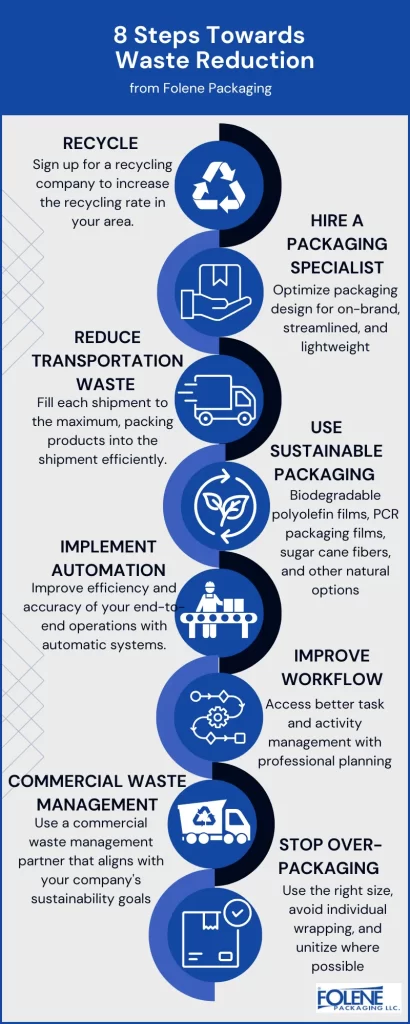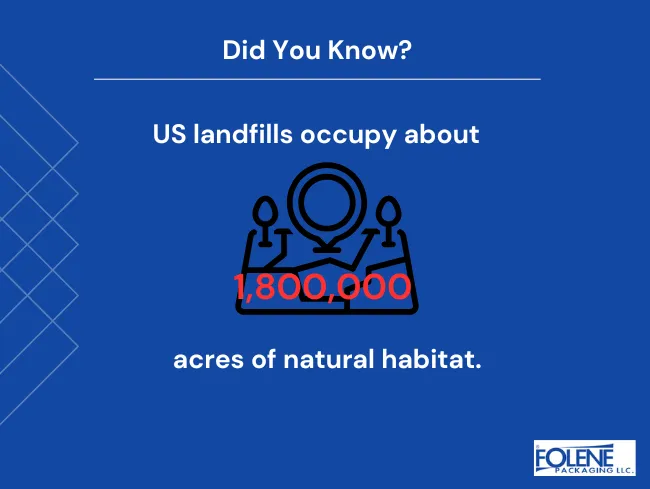
Aside from the colossal expense associated with processing 200 million tons of trash and packaging waste generated by Americans each year (about $50 per ton, or around $2 per person per day), there is growing awareness about irreversible damage being done to the planet. The creation of landfills is destroying up to 1,800,000 acres of natural habitat. Consider that an average landfill site is 600 acres, and about 3,000 active landfills are in the U.S. It’s time to focus on waste reduction projects.
Several movements that educate people about and encourage waste reduction are gaining traction. The phrase “the 3Rs” or “reduce, reuse, recycle” are the slogans of the U.S. EPA’s Waste Reduction Model (WARM), the U.S. Zero Waste Business Council (USZWBC), as well as the United Nations Centre for Regional Development (UNCRD). There has been some progress, but there is still a long way to go for manufacturers, suppliers, distributors, and retailers to reduce waste, with a focus on reducing packaging waste.

Waste Reduction – What is it?
Simply put, waste reduction means creating less waste. This includes efforts to reduce consumer waste, reduce garbage waste (“garbage” technically means solid animal, vegetable and food waste – think kitchen and bathroom) and to reduce waste produced by the retail world. We enjoy using products and discarding them when we are done often creating plastic waste. We rely on packaging for shipping retail products, distribution, and convenience. What can we do to reduce waste?
The EPA (Environmental Protection Agency) developed the 4-step Hierarchy of Solid Waste Management which tells us the preferential order for disposing of unwanted items and waste. Michigan State offers a 5-step hierarchy: The top of the list is to reduce acquiring and using items and reduce waste wherever possible. Next is reusing, which offers many benefits. This is followed by recycling, which requires considerable financial and energy input. The least preferred options are incinerating and landfilling the waste.
Since reusing can be limited and so little plastic is recycled, the objective is to reduce plastic waste. “Reducing” is a much more effective idea than increasing recycling, which can be expensive. Compare it to airing out a room. You could use a ventilator fan. Or you could open the windows and doors, which is faster and more effective. We want to know how to reduce packaging waste in manufacturing. So the United States is focusing on reducing waste.
Why is Waste Reduction Important?
What is waste reduction and how can it affect us? Waste reduction frees us from the different burdens shown below—without counting the associated guilt about environmental destruction and wreckage.
Financial advantages
reduce expenses of avoidable purchases
reduce costs of disposal
Social benefits
class your brand and appeal to customers
improve your business’s reputation
Operational edge
ensure compliance with regulations
discover newer ways for process optimization

Some Types of Waste
The EPA lists the types of waste we generate, from municipal solid waste (MSW) to hazardous and non-hazardous waste, agricultural and garbage, medical, radioactive, and construction waste, waste from producing and combusting fuel and energy, and municipal sewage. Packaged goods are included in the MSW category.
Statistics about trash and recycling continue to astound us as we realize how much trash we generate. Let’s look more deeply at packaging waste generated in the U.S. since a lot of it is generated on a regular basis.
What are types of packaging waste?
Soft plastic wrapping – shrink films, plastic seals, and binding tapes.
Bags – plastic grocery bags, shopping bags, and snack packs.
Rigid plastic containers – freezer boxes, refrigerated product trays, bottles for drinks and sauces, jars and tubes of creams and medications.
Packing and shipping materials – cardboard, plastic, wood packaging, steel packaging
Single use plastics – takeout plastic packaging such as cups, straws, containers and lids
Drink containers – Aluminum packaging and glass containers generated many tons of waste

Whose Resonsibility is Reducing Waste?
The EPA says the U.S. is a developed society. Developed countries usually generate larger amounts of municipal solid waste. That puts the onus on the developed societies to deal with it.
Who runs waste management projects?
Under EPR the producers bear responsibility to run recycling and other waste management programs. In practice, EPR programs and waste reduction projects are the jursidction of national or state governments.
How To Reduce Waste
With awareness and targeted thinking, individuals, communities, and businesses of all sizes can successfully generate less trash. To implement effective waste reduction strategies is within everyone’s reach.
Sam Morady of WasteCostSolutions says everyone can combat the generation of packaging waste by choosing products with less packaging, as an example.
Ways we can churn out less material for waste disposal and pickup:
Ways to reduce waste as individuals
People can shop and take their reusable bags or shopping trolleys with them, saving 100% on the need for new grocery bags.
Reducing waste in communities
Freecycling is becoming commonplace as people pass forward the usable items they no longer need instead of trashing them.
Businesses can reduce waste
Businesses turn waste into cash by recycling paper. Employees are encouraged to use reusable cups. Offices order products with streamlined packaging
8 Ways to Reduce Waste in a Business (With a Focus on Packaging)
Manufacturers, suppliers, distributors, and retailers are a major part of the supply chain. The overall effect will be enormous when each link in the chain works to reduce waste – even if each company makes a small change.
Packaging Material Example
For example, IBISWorld says that as of 2023, there were 623,066 manufacturing businesses in the U.S. If each company saves 100 cardboard boxes a month by using shrinkwrapping instead, in 1 month alone, they would save 62,306,600 boxes going to an incinerator or a landfill.
How do you reduce waste?

Here are some waste reduction methods to get you started in waste reduction in your business:
Participate in recycling. Sign up for a recycling company to increase the recycling rate in your area. If possible, use recycled paper. Educate your employees. Implement a recycling policy after determining if your state offers discounts or benefits for businesses that join its recycling program.
Make sure your team includes a professional packaging specialist. Optimize packaging design to ensure it’s lightweight, cool, and streamlined.
Reduce waste in product transportation Fill each shipment to the maximum, packing products into the shipment efficiently, and partnering with eco-friendly companies to use clean fuel or buying credits towards carbon neutral shipping .
Switch over to sustainable materials for packaging. More and more fibers are being developed from sustainable materials. Examples include sugar cane fibers— in paper and paperboard containers, bagasse, polyolefins, and corn starch—made into air pillows, the ubiquitous biodegradable packing peanuts, bubble wrap that is made from recycled materials or is compostable, recyclable, or reusable, inner packaging made from mushrooms and seaweed.
Use automation to modernize packaging processes. Improve your end-to-end operations. Automated packaging methods improve and optimize the entire process of packaging. Packing becomes more precise, faster, and consistent. People make less mistakes as they work with the automated systems and that means less waste.
Learn about improved workflow techniques. Access better task and activity management with professional planning. Alongside lowering production costs, less fuel and time is wasted. Business owners get the most for the dollar for each employee.
Implement a system of commercial waste management. Use a commercial waste management partner that aligns with your company’s sustainability goals. It depends somewhat on how active your state is when it comes to waste management. The company should provide recycling dumpsters and other tools that will help you sort your waste efficiently and easily.
Stop over-packaging. Using packaging of the smallest size that will do the job and avoiding double wrapping are two examples that will help with waste reduction. Most consumers do not need individually packaged items. Whatever the product, implement a system of packaging waste management to see where you can use less packaging. E-products and medical products are the worst culprits for plastic waste generation.

How Folene Packaging Helps Suppliers With Waste Reduction
Folene Packaging offers suppliers a range of high-quality shrink wraps that can help your company with waste reduction goals while increasing efficiency. Our company guides our customers with our professional experience in reducing plastic waste and reducing reliance on bulky packaging materials – thereby reducing bulk in shipping and increasing transport efficiency.
Folene Packaging shrink wrap comes in various thicknesses, enabling you to wrap large products, small products, twin products, or snugly and safely wrap pallets at a fraction of the cost – while producing much less waste.
Discover a better packaging option. Folene Packaging brands, Flxtite® and Ecolene®, shrink-protect products from jostling around in transport. All our uncrosslinked films are fully recyclable. Additionally, Ecolene® is 100% biodegradable.
Contact Folene Packaging and begin your company’s journey to waste reduction today as you see how our shrink wraps are literally the best fit for your products.



